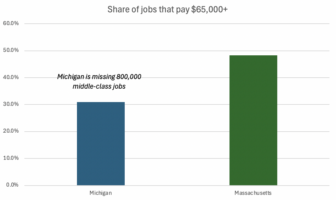Last week my colleague Kim Trent wrote about the rapidity at which automation is changing the job market and the skills that employers are looking for. Hundreds of thousands of Michigan workers have reason to be concerned about whether the jobs they have now will exist in 20, ten, or even five years. For Michigan to help its residents—our neighbors, friends, and family—through this transition, the state will need to take an active role in building adaptability in those whose skills are quickly becoming outdated.
Unfortunately, we’re not even good currently at helping to train unemployed Michiganders for the economy we already know, let alone the economy that’s coming. (No state in the U.S. really is, except when all that is needed is some fairly straightforward skill enhancement or credentialing.) We have been slow to understand—and many still do not—the degree to which automation and globalization are making jobs disappear, whose replacements require a wildly different set of skills. We need to fundamentally rethink how the state can support worker retraining that builds broad skills valued in the new economy.
Examples from other countries show us a couple of approaches that Michigan could take. In Singapore, the government works with employers to produce “industry transformation maps” that reflect expected changes the job market, and that are provided to individuals to help them choose which new skills to pursue. Additionally, the government offers generous subsidies to adults to pursue retraining programs at qualified providers. Singapore recognizes that changes are coming, works with industry to understand those changes, and incentivizes workers to be prepared. (More here, in an article entitled, “Lifelong Learning Is Becoming an Economic Imperative.” It also provides a great explanation of some of the worker displacement that can be expected in coming years.)
In Denmark, a country where, like the U.S., it is relatively easy for employers to hire and fire (unlike many other European countries), displaced workers are paired with a “labor consultant” who makes recommendations for retraining. The use of a consultant who can provide one-on-one support helps Danes overcome many of the hurdles that impair worker retraining programs in the U.S., where worker training programs insufficiently address the numerous barriers faced by the unemployed.
Research in the U.S. suggests that the most effective workforce development programs blend academic, vocational and life skills and highly personalized learning where the curriculum matches the individual needs of the participants. In addition, the most effective training programs either engaged directly with employers or industry sectors, or coached participants in how to find training in in-demand skills.
As the economy changes faster and faster, and we automate jobs that we used to think machines could never do, we need to help Michiganders with narrow skill sets adapt. This doesn’t mean one more certificate or a few more conversations with employers. It means individualized support and the teaching of broad skills. It means taking a good look ahead and completely redesigning workforce development for tomorrow, rather than yesterday.







